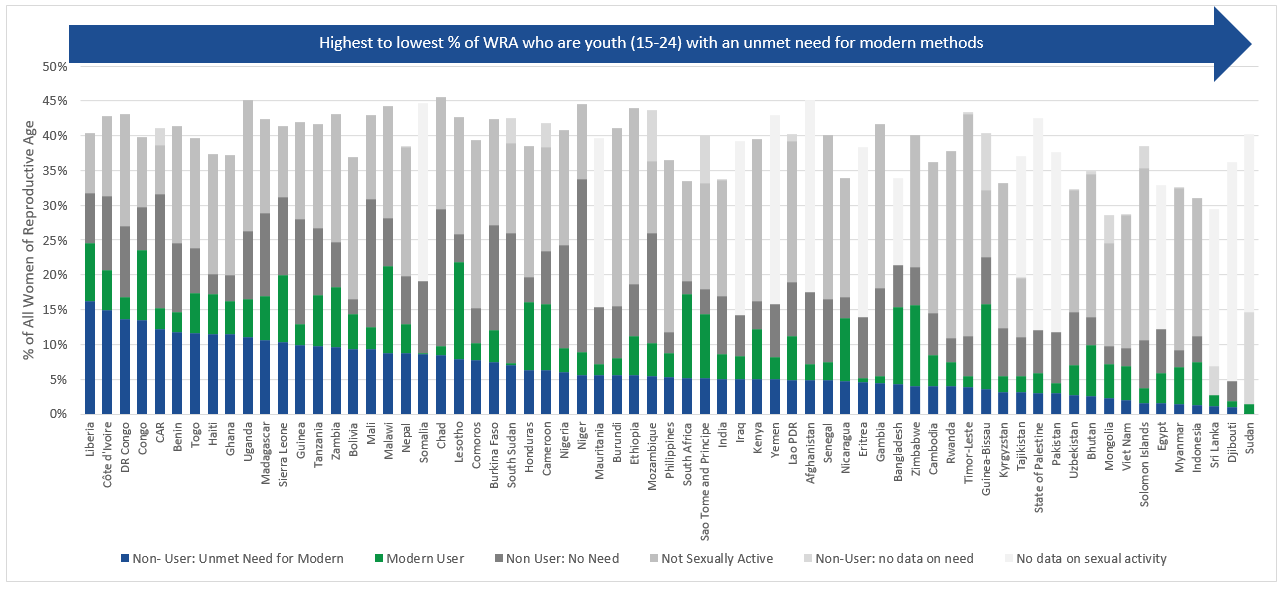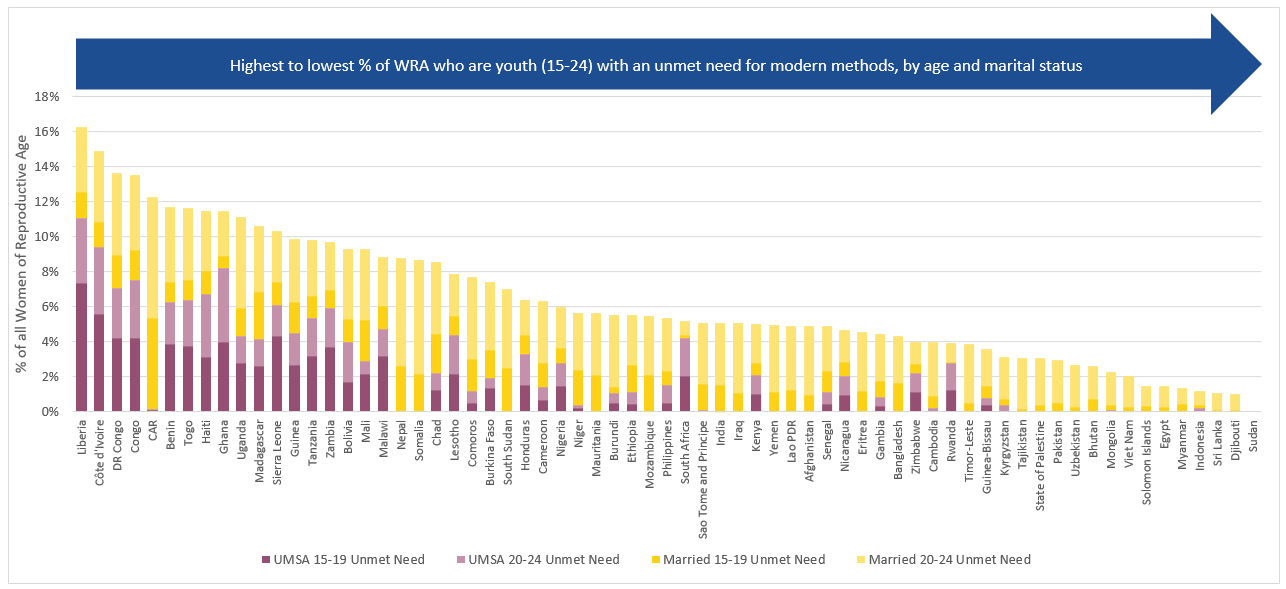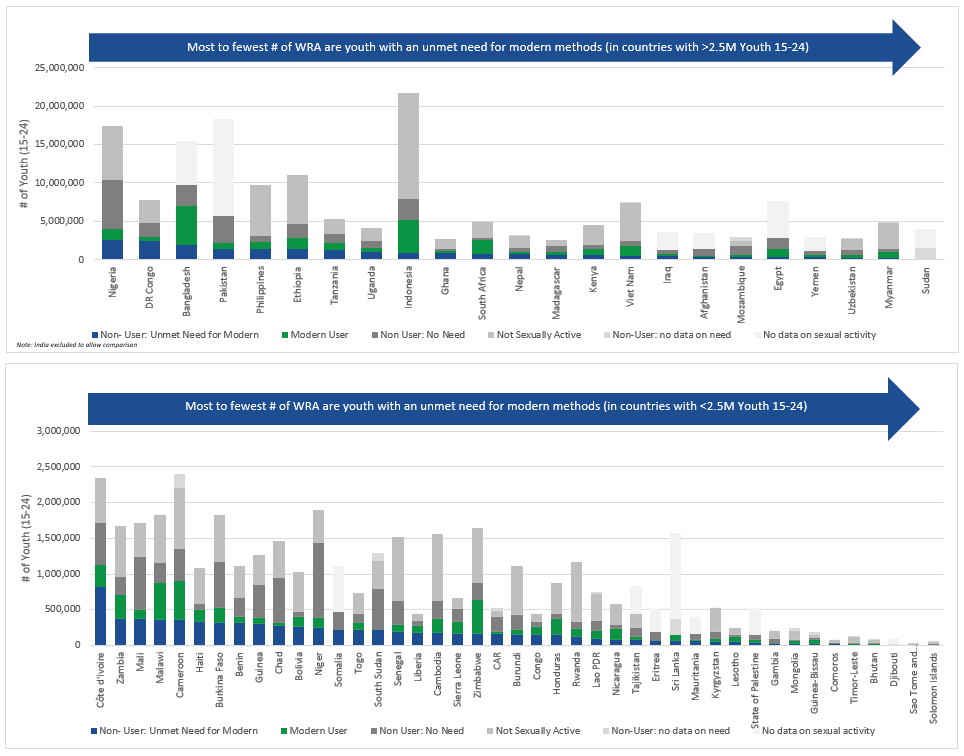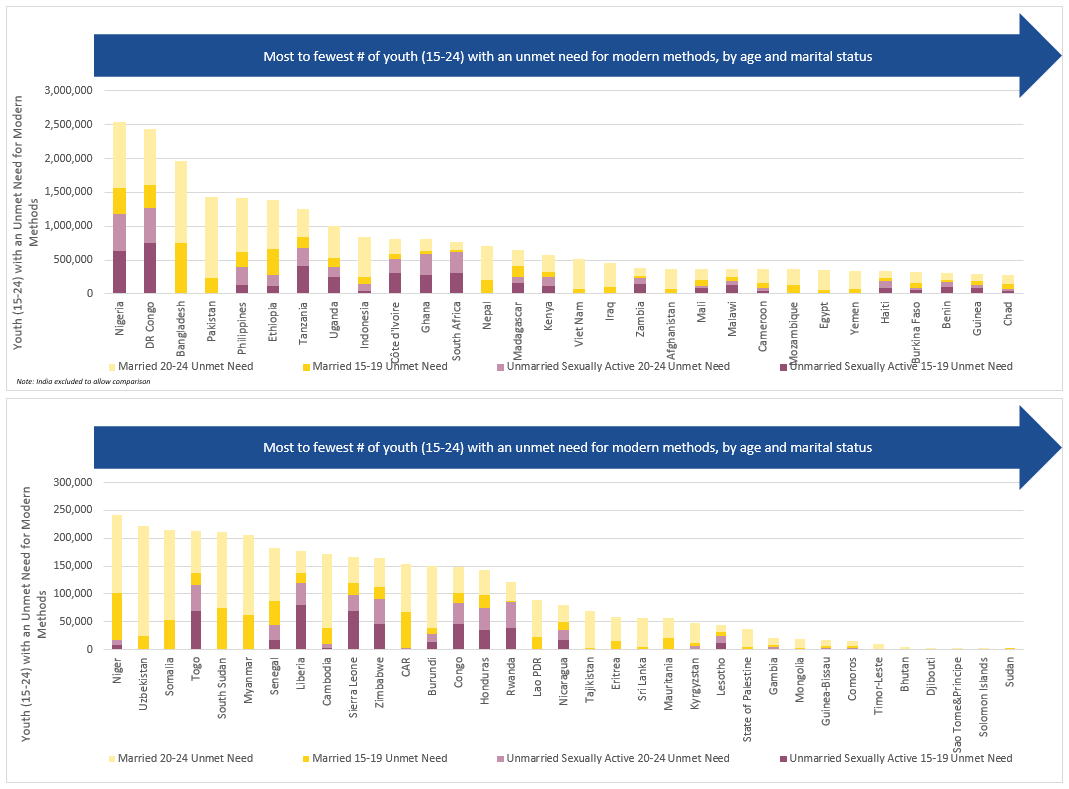When thinking about the potential impact of scaling up youth interventions on national levels of contraceptive use, it is important to take several factors into consideration: what proportion of women in the country are young, what proportion of young women are married, unmarried sexually active, or unmarried and not sexually active, and what current mCPR and unmet need is for each of these groups. Places where a large proportion, or absolute number, of women of reproductive age area estimated to be young, in need of contraception and not using modern contraception present the largest opportunities for investments in youth to lead to growth in mCPR or modern users.
For this opportunity analysis, the focus is on the potential impact on increasing overall contraceptive use. There may be many important investments to be made in young people that do not directly increase contraceptive use, at least in the short term.
To learn more about contraceptive use and non-use among young people visit our special analysis section on Youth.
In this graph, the total height of the bar shows the proportion of all women of reproductive age in the country who are young (15-24).1 The bar is then segmented by use and need for modern contraception2. In many countries, a large proportion of young women do not have a need for modern contraception- either because they are already using, they are pregnant or want a child soon, or they are unmarried and not sexually active.
Countries have been organized from largest to smallest % of WRA who are young women with an unmet need for modern contraception. The next graph breaks this group down further- by age and marital status- to help think about what interventions might be best placed to reach these women. Those countries where young women with an unmet need for modern contraception make up a large proportion of all WRA in the country offer the greatest potential impact on mCPR by doing youth-focused interventions.

1This is calculated using UNPD WPP (2015 Revision) projections (by sex and age) for 2016.
2This has been done based on secondary analysis of the latest DHS or MICS survey in each country (see sources tab).
In this graph, the total height of the bar shows the proportion of all women of reproductive age in the country who are young women with an unmet need for modern contraception (15-24).1,2 The bar is then segmented by age (15-19 v 20-24) and marital status (married v unmarried sexually active)2 where data permits.
When thinking about what interventions for young people can best meet this unmet need, it is important to consider which segments make up the largest proportion of unmet need. In many countries, the largest segment of unmet need is among married 20-24-year-olds, indicating a need to include married youth in youth FP programming. It is important to ensure that efforts match to need in a country. There are also other country contextual factors that are important to take into consideration, beyond what this data can show.
Countries have been organized from largest to smallest % of WRA who are young women with an unmet need for modern contraception. Those countries where young women with an unmet need for modern contraception make up a large proportion of all WRA in the country offer the greatest potential impact on mCPR by doing youth-focused interventions.

1This is calculated using UNPD WPP (2015 Revision) projections (by sex and age) for 2016.
2This has been done based on secondary analysis of the latest DHS or MICS survey in each country (see sources tab).
In this graph, the total height of the bar shows the total number of young women (15-24) in the country.1 The bar is then segmented by use and need for modern contraception2. In many countries, a large number of young women do not have a need for modern contraception- either because they are already using, they are pregnant or want a child soon, or they are unmarried and not sexually active.
Countries have been organized from largest to smallest number of young women with an unmet need for modern contraception. The next graph breaks this group down further- by age and marital status- to help think about what interventions might be best placed to reach these women. Those countries where there are large numbers of young women with an unmet need for modern contraception offer the greatest potential impact increasing modern users through youth-focused interventions.

1This is calculated using UNPD WPP (2015 Revision) projections (by sex and age) for 2016.
2This has been done based on secondary analysis of the latest DHS or MICS survey in each country (see sources tab).
In this graph, the total height of the bar shows the total number of young women with an unmet need for modern contraception (15-24).1,2 The bar is then segmented by age (15-19 v 20-24) and marital status (married v unmarried sexually active)2 where data permits.
When thinking about what interventions for young people can best meet this unmet need, it is important to consider which segments make up the largest number of young women with an unmet need. In many countries, the largest segment of unmet need is among married 20-24-year-olds, indicating a need to include married youth in youth FP programming. It is important to ensure that efforts match to need in a country. There are also other country contextual factors that are important to take into consideration, beyond what this data can show.
Countries have been organized from largest to smallest number of young women with an unmet need for modern contraception. Those countries where there are large numbers of young women with an unmet need for modern contraception offer the greatest potential impact increasing modern users through youth-focused interventions.

1This is calculated using UNPD WPP (2015 Revision) projections (by sex and age) for 2016.
2This has been done based on secondary analysis of the latest DHS or MICS survey in each country (see sources tab).